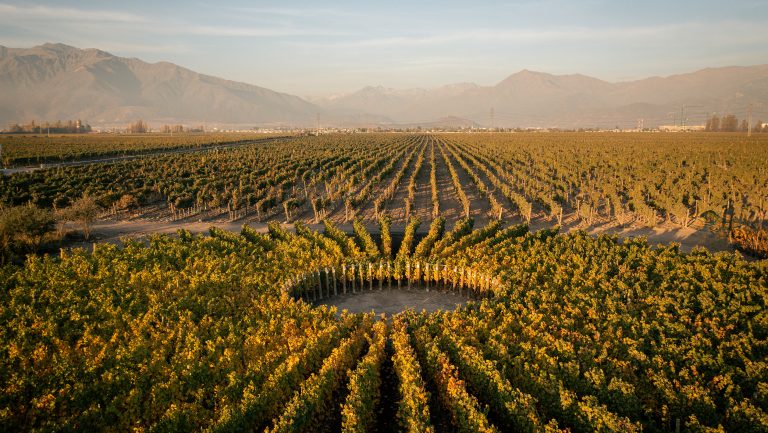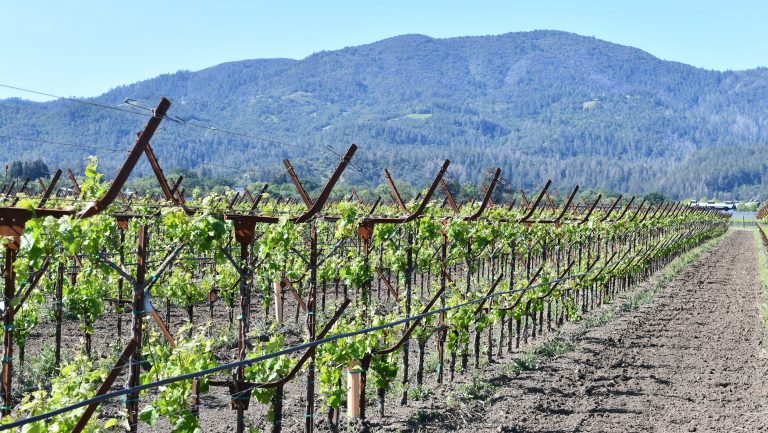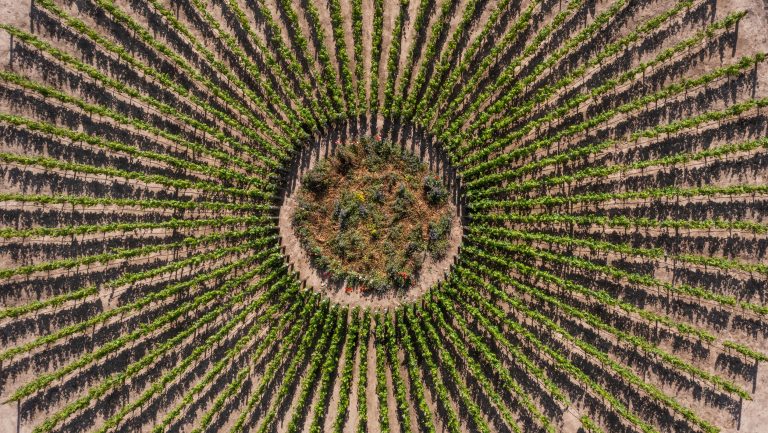Just how much control do vintners have over their microclimate, particularly as climate change poses an increasing threat to wine production around the world? Several are trying to find out.
These efforts are more crucial now than ever: Up to 70 percent of current wine-producing regions across the world will be unsuitable for wine production if temperatures increase more than two degrees Celsius, according to a recent review of more than 200 studies published in Nature Reviews Earth & Environment. Without radical action, scientists at NASA say the world is currently on track to warm between 2.5 and 4.5 degrees Celsius by 2100.
Already, the consequences are being felt in vineyards, as growers with centuries worth of records on harvest dates document earlier and earlier harvest dates. A Beaune record from 1354 to 2018 published in Climate of the Past shows significantly earlier harvests beginning in 1988, right around the time that the impacts of human-caused climate change began to be felt.

Don’t miss the latest drinks industry news and insights. Sign up for our award-winning newsletters and get insider intel, resources, and trends delivered to your inbox every week.
However, earlier harvests can create unbalanced grapes and decrease wine quality. Grape growers may not have control of the warming planet, but they do have agency in the fields they farm. From radial vineyards to dual-varietal trellises, vintners are rethinking vine orientation and training to protect their grapes from hotter temperatures.
Radial and Labyrinth Vineyard Designs
Vineyards, like cities, are often laid out in easy-to-navigate grids. Simple rows make it easier and more practical to farm. Easier for humans, perhaps, but is it optimal for grapes? Two audacious experiments are testing that question in real time.
At Viña Don Melchor in Chile’s Puente Alto appellation, CEO and technical director Enrique Tirado planted a 0.4-acre experimental vineyard with 60 15-meter long rows of grapes to see how vineyards planted with radial orientation will change how grapes develop and ripen.
“We are exploring how row orientation and planting density affect the microclimatic conditions at the cluster level, and how that impacts the quality of the final wine,” Tirado says. “We are looking at temperature, solar radiation, the level of photosynthesis, and the quality and concentration of different elements. All of these factors play an important role in producing and ripening phenolic compounds in the grapes, including sugar, pH, and acidity.”
Tirado says this experimental study is the next logical step for Don Melchor’s 310 acres of vines. In 1997, the vineyard was subdivided according to soil into 151 parcels, with each parcel farmed and vinified separately according to its distinct climatic needs.
“Our first step was creating the different parcels and learning how to farm each one in warmer years and cooler years,” Tirado says. “With the Sundial vineyard, we are aiming to find out how the microclimate for vines can be changed by row orientation and density.”

The Sundial vineyard is comprised of a massal selection of Cabernet Sauvignon from the main Don Melchor Vineyard, planted on ungrafted rootstock in 60 rows, with plantings 50 centimeters apart in the center, and 200 centimeters apart around the perimeter, in a radial pattern of vertically trained vines.
The knowledge Tirado and the team have garnered so far have already caused them to make “significant changes to vineyard management. We’ve seen differences of one to two degrees Celsius in the grapes from row to row on average throughout the season. This information will change how we approach vineyard management well into the future.”
At Oregon’s Dominio IV, winemaker Patrick Reuter has planted two labyrinth vineyards: a one-acre planting that includes Tempranillo, Viognier and Cabernet Franc in Columbia Gorge, and a 0.75-acre planting of eight Pinot Noir clones in Yamhill-Carlton. It started out, Reuter admits, as more of a philosophical thought experiment that he developed with his wife Leigh Bartholomew, the director of viticulture at Results Partners Vineyard Development and Management in the Willamette Valley.
“My wife and I saw that the linear pattern of a typical vineyard is not conducive to a thoughtful and meditative experience,” Reuter says. “We wanted people to engage with the viticulture in a different way. We’ve found that having people walk the pattern and commit to the journey of going into the center and coming out, which takes about 30 minutes, creates a mental catharsis.”
But it’s also led to new viticultural revelations.
“We have discovered that we can delay ripening by planting each vine in the labyrinth in a radial pattern, and training it in a circle,” Reuter says. “We noticed that these vines are now much less susceptible to sunburn, which can happen with VSP [vertical shoot positioning]. This way of training ensures that there is always at least a dappling of shade on the grape.”
While the yield is smaller in the labyrinth vineyards, Reuter says the “quality of the fruit makes up for the loss in yield.”
Doubling Up on Grapes and Changing Directions
Other growers are keeping the grid in place, but transforming what happens within that grid.
Mark Neal, the owner and founder of Neal Family Vineyards in Napa, developed a dual-varietal trellis system in 1997 for his biodynamically farmed grapes.
“I saw that white grapes were getting thrown off and losing acid because of increasingly warm conditions,” Neal says. “I’ve been working as a viticulturist all my life, and because I’m so invested in sustainability the obvious choice of sunshade cloth didn’t appeal to me. It’s not organic and it creates waste.”
Instead, he created a double trellis system, with red varieties like Cabernet Sauvignon planted directly on top of whites like Albariño, Fiano, and Vermentino, which provides shade.
“There have been no signs of additional pressure, and the benefits have been enormous,” Neal says. “Our 18-acres of double trellis now exceeds 12 to 15 tons per acre, essentially doubling the output, without using any additional water. The carbon footprint of farming is slashed in half and the quality of the grapes has actually improved, with higher acid levels and protection from sunburn.”

Neal believes that not only does double-trellis farming create ideal conditions for grapes in an ever-hotter world, it is “the most responsible use of land. Especially in Napa, where vine acreage is at a premium.”
Matt Crafton, the winemaker at Chateau Montelena in Calistoga, California, says that the winery is going through “the biggest replanting since 1972.”
Crafton says the goals are threefold, set within the context of climate change: increasing quality, increasing sustainability, and ensuring longevity of the vineyard.
“We used years of weather data to determine the hottest part of the day, and to figure out exactly what direction the sun would be shining in,” Crafton says. “So in addition to focusing on soil health and adding drought and pest-resistant rootstock, we are changing the orientation of our entire vineyard.”
The vineyards are being replanted diagonally so they orient 25 degrees east of north. “That way, when the sun is the hottest, at 2 pm in July and August, it will be shining directly down on top of the canopy, where the grapes will be protected with shade from leaves,” he says.
In the previous planting scheme, the berries would get direct sunlight during the hottest and sunniest periods, which is often too much, Crafton adds.
In an ever-warmer world, getting the temperature for those grapes just right may be more challenging. But as these vintners show, rethinking old patterns and grids can lead to better results, in the same place, under the same conditions.

Dispatch
Sign up for our award-winning newsletter
Don’t miss the latest drinks industry news and insights—delivered to your inbox every week.
Kathleen Willcox is a journalist who writes about food, wine, beer, and popular culture; her work has appeared in VinePair, Edible Capital District, Bust magazine, and Gastronomica, and on United Stations Radio Networks, among other venues. She recently coauthored, with Tessa Edick, “Hudson Valley Wine: A History of Taste & Terroir.” She lives in Saratoga Springs, New York.







